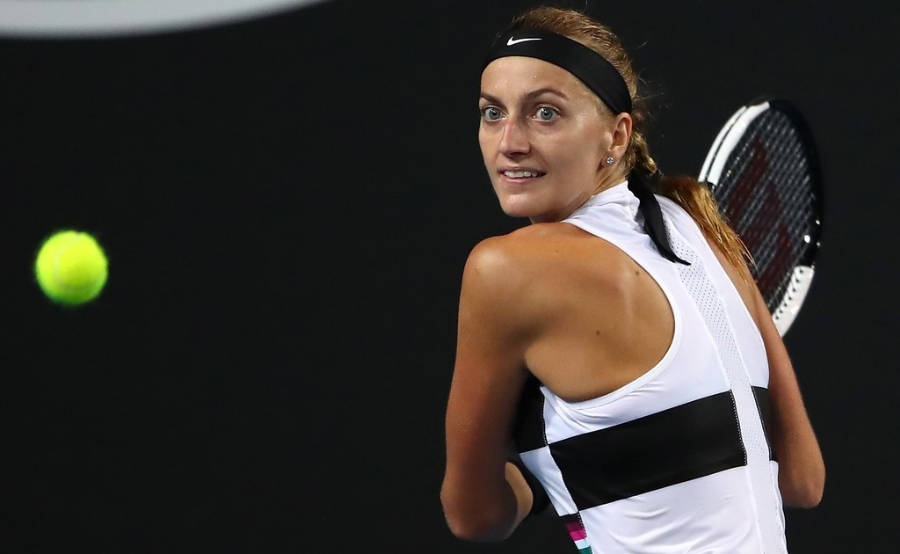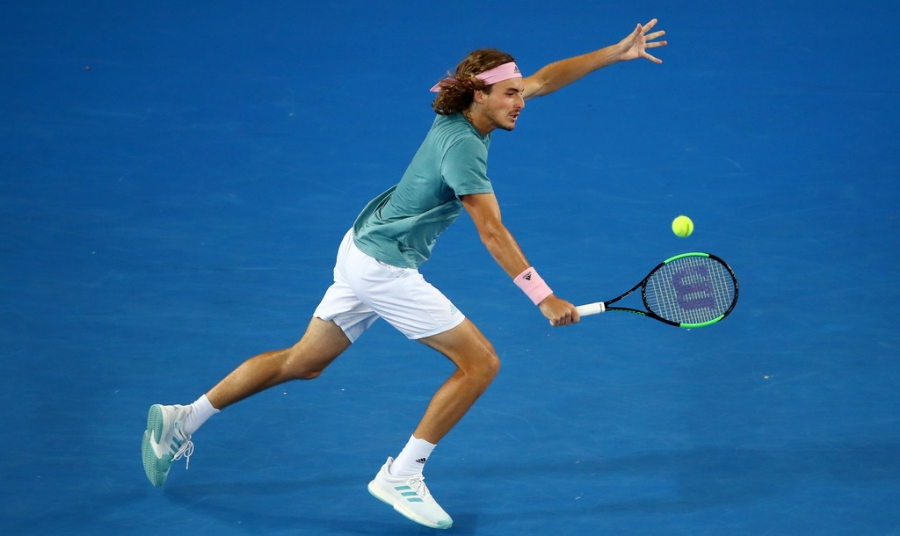Here are my thoughts on a couple of quarterfinal matches, one from each draw, scheduled for Tuesday in Melbourne. At the end of each, I take a shot at predicting the outcome, and I should emphasize that they should not be taken too seriously. I don’t need to remind you of, among others, Collins vs. Kerber and Anisimova vs. Sabalenka in the women’s draw, and Tiafoe vs. Anderson and Tsitsipas vs. Federer in the men’s, do I?
Petra Kvitova (8) vs Ashleigh Barty (15)
My pre-tournament pick Kvitova is marching on in an even more dominating fashion than I expected. One can claim that she’s had a more ‘convenient’ draw, so to speak, than some other quarterfinalists, but whether that claim holds water considering the depth and unpredictability of the women’s field, or whether it justifies the manner in which Kvitova has been flooring her opponents until now, is another story.
There are couple of match-up aspects that swing the pendulum in Petra’s favor. Her lefty serves, especially the ones that slide wide to the ad side, and the fact that she is likely to work the corners of the court during rallies, thus not allowing Barty to take charge from the middle of the court, are couple of problems that the Australian will need to solve. Petra’s serve to the backhand will especially be tough for Barty because she may have no other option but to float one-handed backhand-slice returns back to the middle of the court, and prepare herself as quick as possible, to chase the next strike by Petra. That sounds to me like the kind of pattern that the Czech player would gladly jot down on every page were she in full charge of the scenario. It may sound like a reductive slogan but Kvitova could earn the win with a simple “strike first” stratagem from the baseline, one that already exists in the core tenet of her preferred style of play. I also expect her to include the occasional drop shot in her game plan, for better or worse.

If Barty manages to have a good day on her first serves, her horizons turn much brighter. In their entertaining encounter from earlier this year in Sydney (Kvitova won 1-6 7-5 7-6), Barty came very close to victory, ending with more points won in total than her opponent, I thought her inability to land her first serve in on a few key points was one of the factors that played a role in the final score. She finished the match with a 60% first-serve rate.
So far in Malbourne, she has fared slightly above that, but not by much, recording 65% – 61% – 68% – 60% respectively against Kumkhum, Wang, Sakkari, and Sharapova. If she can rise beyond her average so far and climb to a 70% or above first-serve percentage, the problem-solving task may shift over to Petra’s shoulders. It’s not just a number in Barty’s case, because its ramifications not only matter to the number of free points she may collect on the missed returns or aces, but also to her ability to confine Kvitova to the area behind the baseline, forcing her into a defensive mindset for an extended number of points. Hopefully for Ashleigh, those periods in the match will be long enough to derail the Czech’s attacking groove so that some degree of hesitation may materialize in Petra’s mind and carry over to her own serving games.
I would also not be surprised to see Barty approach the net as much as possible, all the while accepting that some fierce passing shots could zoom by her at the net. To some degree, that is to be expected, although Barty can cut down on their numbers by placing the approach shot well enough to make Kvitova stretch for them. The larger scope of this type of aggressive disposition in tactics from Barty’s standpoint is to bank on its long-term impact on Kvitova in the latter portions of each set when pressure mounts. Let’s also remember that Petra will likely deal with a pro-Barty crowd.
I am giving a slight edge to Kvitova who, in two close sets, should improve her head-to-head record against the Australian to 4-0.
Stefanos Tsitsipas (15) vs. Roberto Bautista Agut (23)
Due to multiple reasons, the task of making an educated guess on this match’s outcome is an exercise in futility. For starters, they never faced one another before. More importantly, how the two feel in the physical-shape department when the they step on the court on Tuesday will likely remain a mystery to everyone – except them – until the designated server tosses the ball up for the first point of the match. It’s only once it begins that we can observe their footwork and mental sharpness, and carve an opinion on how much endurance each has left following the mentally and/or physically exhausting victories that they amassed in the previous four rounds. Not before.
Tennis fans who follow Agut know better than to be fooled by the Spaniard’s relatively modest stature. He has been nothing short of a freight train in 2019, knocking down one adversary after another, and soaring to a 9-0 record for the year. Those opponents are no slouches either, Novak Djokovic, Andy Murray, Stan Wawrinka, Karen Khachanov, Marin Cilic, to name some.
In the Australian Open, he has been getting it done via cool-headed and gritty performances, three of which have extended to five sets. He offers no gifts, does not shy away from marathon points, and appears to be in incredible shape. Agut is that nightmare opponent who fools you into playing unimpressive points that accumulate overtime and soon begin to weigh on you like an ongoing nightmare. You think you will soon wake up, but you don’t. And if you do, you can’t quickly shake it off.
The above qualities should not be casually dismissed because they will loom large for Tsitsipas who will not enjoy the luxury he had against Federer on whose errors he could count when the opportunity to attack the net did not present itself. Agut may not serve like Federer, and he is not nearly as creative as the Swiss, but he will commit only a fraction of the errors that Federer did from the baseline, firmly planting in Tsitsipas’s head that he cannot take comfort in the assumption that his chances are good in extended rallies. In fact, if Agut had his choice, extended rallies would be top priority in his wish list. Stefanos will need to solely rely on his accelerations and approaches to the net, with not much help coming from elsewhere.
For Tsitsipas, there is also the added challenge of mentally handling the aftermath of the biggest win in his career, his four-set victory over Federer on Sunday, and do so while facing a clutch opponent. This is not a trivial matter because several players stunned members of the big 3 in Majors in the past, only to turn around and produce lackluster performances in their next round.

Tsitsipas, not unlike Barty in my preview above, needs a high first-serve percentage, preferably 70% or above (he has remained below that mark in his four matches). I am not sure that a repeat of his 60% vs. Roger is enough to make the cut. He needs those first serves to take charge in the follow-up shot and approach as much as he can. Tsitsipas covers the net well and possesses apt volleying skills. He is not afraid to venture up there either, so I expect a 1-2 punch ‘serve-and-approach’ tactic – or even a ‘return-and-approach’ one on some of Agut’s second serves – to be an integral part of his game plan.
Another determining factor in increasing the Greek’s chances to win lies in how well he can deal with the steady flow of low-bouncing balls struck his way by Agut. The Spaniard does not hit with heavy topspin, so Tsitsipas should know that he will not be able to take too many big cuts on balls that sit up high for him to make contact at the chest-to-shoulder level, his preferred contact-point height on groundstrokes. His consistency on shots struck below the hip level will be under scrutiny, and his backhand slice will be tested.
For all the unknowns above and more, be my guest in guessing the outcome. I am going to roll the dice with Tsitsipas, mainly because I would like to see the youngster back his career-best victory up with another remarkable one and separate himself from others in his generation (excluding Zverev). And I mean that as a motivational force for the others. I remember Milos Raonic saying a few years back in a press conference that Stan Wawrinka winning the Australian Open in 2014 did wonders in the locker room for guys like him who were chasing the dream of shaking the big 4’s stranglehold on Majors. Stan’s win represented a wake-up call for them, proving that it was indeed possible. Tsitsipas reaching the semis (or more) here may have the same kind of impact on his generational peers and give them a boost, thus accelerating the process of narrowing the current gap that seemingly exists between the top elite players and the rest of the men’s field.
